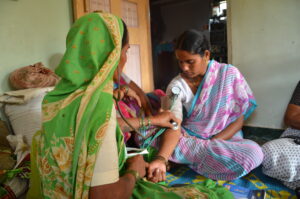What It Does
 Nearly 50 years ago, in rural Maharashtra, India, CRHP Jamkhed became one of the first organizations in the world to pioneer a comprehensive model that combines a community-based health approach with social and economic development. Today, CRHP continues to serve more than 500,000 people through a broad set of programs that address both direct healthcare needs and underlying socioeconomic causes of poor health, such as inadequate sanitation, limited economic opportunity, low status of women, social stratification, and other harmful beliefs/practices.
Nearly 50 years ago, in rural Maharashtra, India, CRHP Jamkhed became one of the first organizations in the world to pioneer a comprehensive model that combines a community-based health approach with social and economic development. Today, CRHP continues to serve more than 500,000 people through a broad set of programs that address both direct healthcare needs and underlying socioeconomic causes of poor health, such as inadequate sanitation, limited economic opportunity, low status of women, social stratification, and other harmful beliefs/practices.
Through CRHP’s “Jamkhed Model,” Village Health Workers (VHWs), local women selected by their communities, provide essential primary care and health education to their village, in partnership with CRHP’s Mobile Health Teams and local health facilities. VHWs also help mobilize villagers to create their own solutions to local problems, in coordination with community groups such as farmer’s clubs, women’s groups and microfinance groups, and adolescents.
The Jamkhed Model supports a village’s lasting transformation by building local leadership capacity. Once basic programs such as water and sanitation infrastructure are functioning, community leaders manage their villages’ development, and the village “graduates” from CRHP. On average, villages “graduate” in five years and can receive ongoing support and training from CRHP. The model then spreads from village to village through word of mouth, often via individuals who have experienced the process. CRHP currently operates a 50-bed hospital, training center, preschool, 100-acre farm to demonstrate sustainable farming techniques, and a rehabilitation center for people with stigmatized conditions such as leprosy, tuberculosis, and HIV/AIDS.
CRHP’s success in improving local health outcomes has also influenced policy and public systems, including the government of India’s National Rural Health Mission, that reaches hundreds of millions more people. Since 1992, CRHP’s Jamkhed International Institute has trained 30,000 national and 3,000 international representatives from NGOs and governments, as well as university students, in CRHP’s proven approach. The Institute helps policymakers, practitioners, and students from around the world learn from local villagers and staff about CRHP’s groundbreaking model and adapt it to their own context and challenges.
How Effective Is It
When CRHP started in 1970, Maharashtra had some of the worst health and poverty indicators in the world. In CRHP villages in Maharashtra, the Jamkhed Model has nearly eliminated child malnutrition, dramatically improved child survival, and improved maternal health outcomes. In prior surveys of project villages, more than 99% of pregnant women in CRHP villages received prenatal care and had safe deliveries, and the resulting maternal death rate was 50% less than that of India overall—despite the fact that these villages are among the poorest in India. Similarly, with comprehensive programming, CRHP succeeded in cutting the rate of infant deaths to less than half that of neighboring areas in rural India. Today, CRHP continues to apply its proven approach to emerging health problems such as diabetes, hypertension, and mental health.
How You Can Help
Donors can support the expansion of the Jamkhed model to new villages. On average, it costs CRHP $50,000 to implement its model for an average village of 1,500 people, over a period of about five years. For example, $50 covers the training, travel, and food for one VHW for one month, and $40 covers one mobile health team village visit. Philanthropy can also help support CRHP’s Training Institute, where community organizations from around the world can learn CRHP’s comprehensive strategy. Donors can also fund new initiatives such as the adolescent girls and boys programs, sustainable agriculture, and clean water projects, which target evolving needs in communities. Donate at https://www.jamkhedcrhp.org/.
